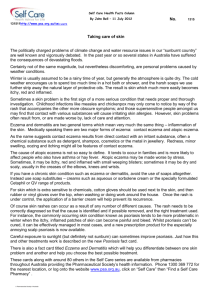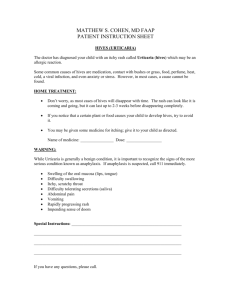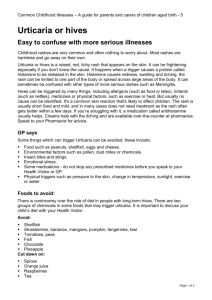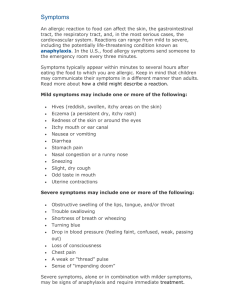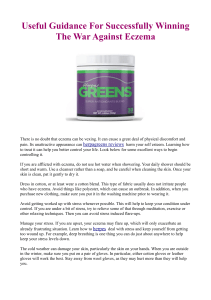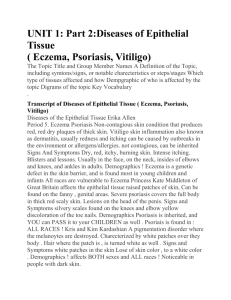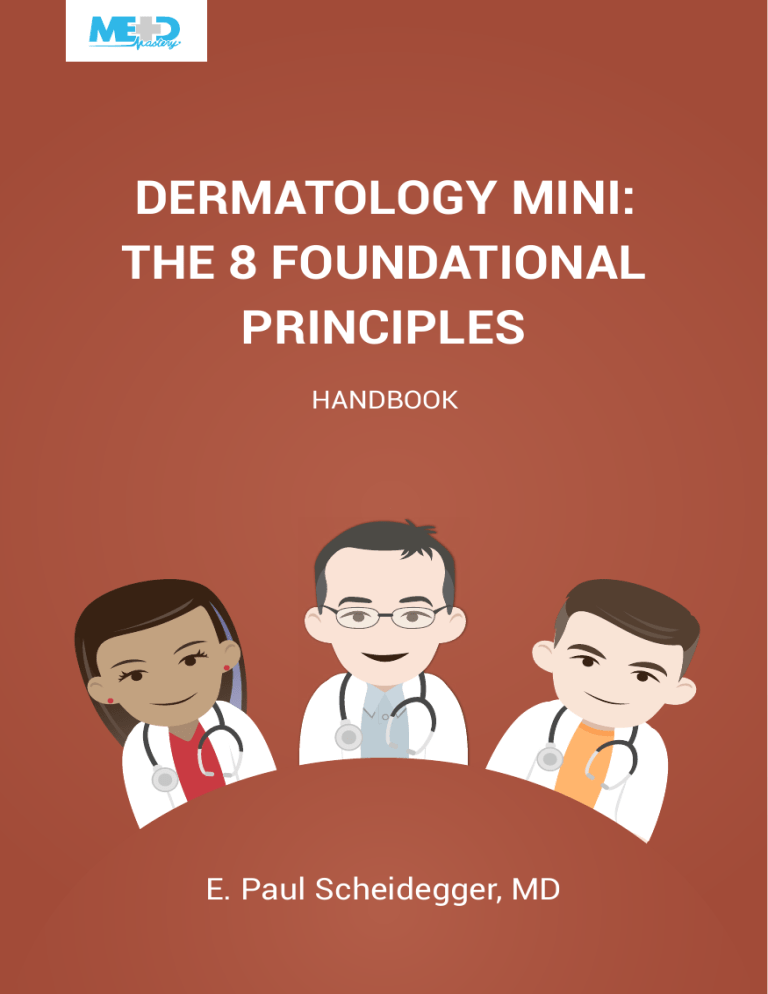
DERMATOLOGY MINI: THE 8 FOUNDATIONAL PRINCIPLES HANDBOOK E. Paul Scheidegger, MD Table of contents Eight foundational principles in dermatology Recognizing eczema 4 Identifying a one-sided lesion as a tumor or infection 11 Recognizing bilateral lesions as non-infectious 16 Diagnosing a transient rash as urticaria 20 Treating a scaling skin surface with a topical medication 23 Treating a smooth skin surface with systemic therapy 26 Diagnosing itchy versus non-itchy rashes 30 Looking for enanthema 35 Putting it all together 38 Appendix Reference list Become an expert at www.medmastery.com. 43 2 EIGHT FOUNDATIONAL PRINCIPLES IN DERMATOLOGY www.medmastery.com Recognizing eczema The most common dermatological condition that you will encounter in daily practice is eczema. In this Medmastery lesson, you will learn how to recognize and treat patients with this condition. So, what exactly is eczema? Eczema (or dermatitis) represents a group of non-infectious conditions in which the skin becomes inflamed, dry, and scaly. Clinically, eczema can be diagnosed according to the four following criteria: 1. Itchiness 2. Red color (also called erythema) 3. Blister formation 4. Scaling Typical clinical examples Take a look at the two images of eczema shown below. Usually, a rash caused by eczema exhibits a reddish, rough, and scaling or blistering surface. However, it is important to know that on non-white skin, this red color can be more subtle. In patients with brown or black skin, the rash caused by eczema tends to look darker brown, purple, or ashen grey in color. Become an expert at www.medmastery.com. 4 In the absence of characteristic redness, other symptoms may help physicians confirm the diagnosis: • Skin swelling • Warmth • Scaling • Itching Eczema in darker skin Unique forms of eczema may also be observed in those with darker skin. For example, African Americans more commonly develop small bumps on their legs, arms, or torso. These bumps may develop around hair follicles and resemble goosebumps. This is known as follicular accentuation. It is important to be aware of these differences when assessing your patients. Become an expert at www.medmastery.com. 5 Histology In each case, taking a skin biopsy from a patient with suspected eczema for histological analysis can help confirm your diagnosis. Take a look at the illustration of the hematoxylin and eosin-stained histological section of skin shown below. The skin is composed of two main layers: the epidermis and the dermis. In patients with eczema, inflammation causes damage to the epidermis, resulting in a characteristic spongiotic tissue reaction pattern. With this spongiotic tissue reaction, the epidermis appears to be full of bubbles, and this explains the rough surface or presence of small blisters that can be observed upon closer clinical inspection of patients with eczema. It is this spongey surface appearance that dermatologists look for to support the diagnosis of eczema. Become an expert at www.medmastery.com. 6 Distribution The distribution of the patient’s rash can also provide important clues for diagnosis. If you look closely, you will find a bilateral and more or less symmetrical distribution of the red, scaling, and itchy bumps in most cases of eczema. The severity might be different on the left and right sides of the body, but this is still considered to be a symmetrical pattern. Therefore, one-sided (or isolated) rashes are typically not eczema. Eczema also comes and goes over several days or weeks, and it is typically a non-migratory condition. Main causes There are many causes of eczema, but the main cause is underlying inflammation which is induced by one of three factors: 1. Allergens 2. Genetics 3. Environmental factors Next, let’s go over the two main causes of eczema: 1. Atopic dermatitis 2. Exsiccation dermatosis Atopic dermatitis The most common cause of eczema is atopic dermatitis, which is an inherited chronic inflammatory skin condition. It results in itchy, red, swollen, and cracked skin. Clear fluid may also leak from the affected areas. Become an expert at www.medmastery.com. 7 Exsiccation dermatosis Exsiccation dermatosis is another common cause of eczema. This occurs after excessive exposure to water and can develop when you wash your hands regularly or shower too often. Therefore, it is of utmost importance to regularly apply a moisturizer after washing and showering. Helpful tips Eczema may look similar to other skin conditions, but there are some important tips and tricks that can help you recognize and diagnose patients with eczema without needing to refer them to a dermatologist. Let’s go over three. 1. Eczema is the most common condition One key thing to remember is that eczema is the most common skin condition in ambulatory care, so if the patient’s history is lacking or noncontributory, or the images are poor, then assume it is eczema until proven otherwise. 2. Eczema is itchy Itch is a hallmark of eczema, so if a rash diagnosed as eczema does not itch, then you must consider a different diagnosis. 3. Eczema does not cause a rash in the mouth Eczema is typically not seen together with a rash in the mouth (known as enanthema). So, if your patient presents with both a rash on their skin and enanthema, then you must consider a different diagnosis. Become an expert at www.medmastery.com. 8 Eczema versus urticaria Urticaria or hives is a common condition that is often confused with eczema. Both conditions cause the skin to appear red, are symmetrical in distribution, and are very itchy. However, there are two key differences that can help you distinguish between urticaria and eczema: 1. Urticaria is a migratory skin condition so it moves around within 6–12 hours, whereas eczema is a more stationary condition. 2. Urticaria has a non-scaling, smooth surface, whereas a scaling or rough surface is a characteristic sign of eczema that is never found in patients with urticaria. Treatment Once you have reached a diagnosis of eczema, the next step is, of course, treatment! The most effective treatment of eczema is the use of topical steroids (1–2 times daily). You should also advise your patients to take the following precautions: • Stop any prior treatments and care products because they can be sources of irritation or contact allergies • Reduce contact with water • Use a fragrance-free moisturizer without urea, since urea and fragrances can potentially cause stinging or skin irritation Become an expert at www.medmastery.com. 9 So, there you have it! Keeping all of these important points in mind will help you recognize and treat eczema in the clinic. And remember, eczema is the most common skin condition, so if your patient has a rash that you can’t identify, administer a trial of topical steroids twice daily for 5 days. Most skin conditions should improve or even disappear with this course of action. If not, then call the dermatologist! Return to table of contents. Become an expert at www.medmastery.com. 10 Identifying a one-sided lesion as a tumor or infection Being able to recognize a tumor or infection is the most important skill in dermatology because these are urgent dermatological conditions. In this lesson, you will learn that a one-sided or solitary lesion may indicate a tumor or infection, and we will review some of the most common causes of these pathologies. Below is an image of an epidermal cyst, which is a benign tumor, and an image of a common fungal infection. Both should be addressed with high priority, but they can sometimes look very similar to other less urgent skin conditions. Let’s go over a few tips that will help you to differentiate. How to differentiate tumors and infections from less urgent diagnoses Let’s cover two important things to consider when you are trying to distinguish between tumors, infections, and less urgent diagnoses: 1. Check the other side 2. Notice the distribution Check the other side The key to arriving at the correct diagnosis is to assess the other (i.e., contralateral) side of your patient to confirm that the skin condition is actually one-sided, which would indicate a tumor or infection. The patient may not have exposed the other side when preparing for the exam, so you may need to help Become an expert at www.medmastery.com. 11 them to do so. They may even be hesitant to undress further because they don’t see the need, but it is important to be persistent because examining both sides will help you to determine the urgency of the condition. If a lesion turns out to be bilateral (i.e., found on both sides of the body), then you have to consider non-infectious or non-tumorous skin conditions, such as inflammatory skin disorders. Notice the distribution The distribution is also important. When you see a solitary distribution where only one part of the body is affected, it likely indicates the presence of a tumor or infection, which requires immediate medical attention. How to recognize common tumors and infections Next, let’s learn how to recognize six of the most common tumors and infections: 3. Melanoma 4. Basal cell carcinoma 5. Impetigo 6. Tinea 7. Lyme disease 8. Herpes simplex Become an expert at www.medmastery.com. 12 Melanoma Melanoma is a potentially serious type of skin cancer characterized by the uncontrolled growth of melanocytes, which are pigment-producing cells. Melanoma typically has the following features: • Brown or pigmented tumor • Asymmetric in shape or form • Often exhibits more than one color • Typically shows some type of change or growth Basal cell carcinoma Basal cell carcinoma is the most common form of skin cancer. It arises from the follicular or basal keratinocytes in the epidermis and is a locally invasive cancer. Clinically, basal cell carcinoma has the following features: • Solitary • Expansile • Often with elevated borders • Typically ulcerated in the center • Non-pigmented Impetigo Impetigo is a highly contagious superficial bacterial skin infection. Patients with impetigo typically present with the following signs: • Pustules • Honey-colored crusted erosions Become an expert at www.medmastery.com. 13 Tinea Tinea is a superficial fungal infection of the skin that can affect any part of the body. It is commonly referred to as ringworm. Tinea presents with the following signs and symptoms: • Characteristic ring-shaped lesions • The lesions are often itchy Lyme disease Lyme disease is a tick-transmitted infection caused by the Borrelia bacterial species. Around 7 to 14 days after the infected tick bite, a red, expanding patch of skin typically appears. This is the most characteristic sign of Lyme disease and is known as erythema migrans. Herpes simplex Lastly, herpes simplex is a common viral infection that causes localized blistering. Herpes simplex is known as cold sores or fever blisters, as recurrences are often triggered by a febrile illness, such as a cold. Become an expert at www.medmastery.com. 14 Putting your skills into practice Importantly, these common tumors and infections all show a one-sided or solitary pattern. Let’s look at an example of how this type of distribution can help you narrow down your diagnosis. Let’s say that you see a patient who is complaining of lesions on their right leg. Which diagnoses would you suspect if What if you checked the contralateral the lesions had a one-sided, localized side and discovered that both legs appearance? were affected? In this scenario, you may suggest a In this scenario, eczema or psoriasis diagnosis of an infectious condition, is a more likely diagnosis because such as tinea. these non-infectious conditions typically affect both sides of the body. Return to table of contents. Become an expert at www.medmastery.com. 15 Recognizing bilateral lesions as non-infectious Skin lesions with a bilateral distribution (meaning that they are found on both sides of the body) are typically non-infectious in nature. In this lesson, you will learn how using this principle can help narrow down your diagnosis, and we will review the most common non-infectious conditions that cause bilateral skin lesions. Non-infectious, bilateral skin conditions Let’s cover four common non-infectious, bilateral skin conditions: 1. Eczema 2. Urticaria 3. Psoriasis 4. Drug eruption Eczema Eczema is characterized by the following signs and symptoms: • Red skin • Scaling • Itchy skin While eczema can have several patterns, it typically has a bilateral and more or less symmetrical distribution. Become an expert at www.medmastery.com. 16 Urticaria Urticaria is another likely cause of bilateral lesions. It is characterized by one or both of the following signs: • Wheals (i.e., hives) • Angioedema (i.e., swellings) A hive is a superficial, skin-colored swelling, usually surrounded by redness, that lasts anywhere from a few minutes to 24 hours. Hives are usually very itchy and may cause a burning sensation. Angioedema is deeper swelling within the skin or mucous membranes that can be skin-colored or red. It typically resolves within 72 hours. Angioedema may be itchy or painful but is often asymptomatic. Urticaria typically has a bilateral and symmetrical distribution. Psoriasis Psoriasis is a chronic inflammatory skin condition characterized by the following features: • Red, scaly plaques • Clearly defined borders • Plaques can affect any part of the body Psoriasis is particularly common in Caucasians but may affect people of any race. There is also a genetic component as approximately one-third of patients with psoriasis have a family member with this condition, which can help with your diagnosis. Become an expert at www.medmastery.com. 17 Typically, the red, scaling, non-itchy lesions of psoriasis have a bilateral and symmetrical distribution. Drug eruption A drug eruption is another common, non-infectious cause of bilateral lesions. A drug eruption is an adverse reaction of the skin to a drug. Many drugs can trigger this allergic reaction, but antibiotics are the most frequent cause. The eruption may resemble exanthems (i.e., skin rashes) caused by viral and bacterial infections. But an important tip to remember is that a skin rash in adults is usually due to a drug, whereas a skin rash in children is typically caused by viral or bacterial infections. This type of rash can also closely resemble eczema, but scaling is not as prominent as it is in patients with eczema. So, drug eruptions have the following signs: • Red skin • Itchy skin Become an expert at www.medmastery.com. 18 Typically, the distribution of a drug eruption rash is bilateral and symmetrical. So, if your patient has bilateral, itchy skin lesions with a more or less symmetrical distribution, think non-infectious conditions, and always make sure to inspect the entire body to ensure that you don‘t miss this important clue! Return to table of contents. Become an expert at www.medmastery.com. 19 Diagnosing a transient rash as urticaria The most likely cause of a transient rash is urticaria. In this lesson, you will learn strategies to recognize and treat this condition. Signs and symptoms of urticaria Patients with urticaria present with wheals (i.e., hives), angioedema (i.e., swellings), or both. Urticaria can affect any site of the body and tends to be widely distributed. Urticarial hives Urticarial hives can be skin-toned or red in color and may be surrounded by a red flare. The hives can be round or form giant patches. They are typically very itchy and move around within 6 to 12 hours. It is important to know that the redness surrounding hives in urticaria patients with darker skin may be more subtle. In these patients, hives will appear as swollen or raised bumps and will typically spread over a larger area of skin compared with what is observed in patients with light skin. Become an expert at www.medmastery.com. 20 Angioedema Angioedema is a swelling of the skin or mucus membrane. Angioedema in the mouth The presence of angioedema in the mouth indicates a more urgent dermatological condition because the swelling may be obstructing the upper airway. If a patient presents with angioedema in the mouth in the absence of hives, this may indicate life-threatening conditions, such as hereditary or acquired angioedema. These patients should immediately be given a systemic steroid, antihistamine, and sometimes even adrenaline. Acute versus chronic urticaria Acute Urticaria can be either acute or chronic. In patients with acute urticaria, the hives are present for less than 6 weeks and typically resolve on their own. Chronic In those with chronic urticaria, hives are present for longer than 6 weeks. Chronic urticaria is often referred to as idiopathic (meaning the exact cause is unknown), but it is likely caused by an autoimmune or autoallergic mechanism. Become an expert at www.medmastery.com. 21 The most common form of chronic urticaria is urticaria factitia, which is characterized by redness and swelling following a minor rub, stroke, or scratch of the skin. Treatment of urticaria The main treatment of all forms of urticaria in adults and children is an oral second-generation antihistamine. If the standard dose (e.g., 10 mg for loratadine or any other non-sedating antihistamine) is not effective, the dose can be increased up to fourfold (up to 40 mg of loratadine daily). Once the urticaria has settled down, treatment should be stopped. Become an expert at www.medmastery.com. 22 Treating a scaling skin surface with a topical medication A scaling skin surface is often triggered by an epidermal insult and should be treated with a topical medication. In this lesson, you will learn about the different conditions that cause scaling and what treatments will be most effective. Two common scaling skin conditions Let’s discuss two common scaling skin conditions: 1. Eczema 2. Psoriasis Eczema Eczema is a common skin disease that exhibits scaling. In fact, scaling is one of the criteria used to clinically diagnose this condition. Become an expert at www.medmastery.com. 23 Psoriasis Psoriasis is a chronic inflammatory skin condition characterized by red and scaly plaques that can affect any part of the body. Differentiating between eczema and psoriasis Eczema and psoriasis can look very similar as patients with these conditions both exhibit a scaling surface. However, the presence of scaling plus itchiness indicates that your patient likely has eczema. On the other hand, a scaling surface that does not itch suggests that this patient likely has psoriasis. Become an expert at www.medmastery.com. 24 Treatment of eczema and psoriasis Psoriasis and eczema are typically treated with emollients and moisturizers. Emollients are used to soften the skin’s surface when it exhibits scaling by filling in the gaps between skin cells. Moisturizers are used to add moisture to the skin. Return to table of contents. Become an expert at www.medmastery.com. 25 Treating a smooth skin surface with systemic therapy A non-scaling, smooth surface indicates systemic inflammation originating in or around the vasculature of the skin (for example, in the dermis) and should be treated with systemic therapy. In this lesson, we will review the most common conditions that show a smooth, non-scaling surface, and you will learn what treatments will be most effective. Four common smooth skin conditions Let’s cover four smooth, non-scaling skin conditions: 1. Urticaria 2. Erysipelas 3. Viral or bacterial toxin exanthema 4. Drug eruptions Urticaria Urticaria characterized by hives and swellings is a common skin condition that is caused by internal inflammation. Urticaria is treated with an antihistamine and / or steroid, and it is important to know that emollients and other topical treatments will be ineffective. Become an expert at www.medmastery.com. 26 Erysipelas Erysipelas is a potentially serious bacterial infection of the skin. It is also known as St. Anthony’s fire due to the intense rash associated with it. When erysipelas involves the face, the affected skin has a very sharp, raised border and a smooth appearance. Viral or bacterial toxin exanthema A viral or bacterial toxin-related exanthema is a widespread rash accompanied by systemic symptoms, such as fever, headache, and malaise. Exanthemas during childhood are usually associated with viral infections. Typically, a viral exanthema exhibits a non-scaling, smooth surface, although there are notable exceptions to this clue. Become an expert at www.medmastery.com. 27 No treatment is required for most patients with non-specific exanthemas as the condition is usually short-lived and resolves spontaneously. If necessary, symptomatic treatment with acetaminophen to reduce fever in combination with an oral antihistamine or emollient to relieve itch and dryness may be used. Lyme disease Lyme disease is an infection caused by the Borrelia species. Erythema migrans, which is a smooth, expanding red patch of skin, is the most typical sign of Lyme disease. Erythema migrans is mostly asymptomatic but can be itchy, sensitive, or warm if touched. Lyme disease is typically treated with systemic antibiotics. Drug eruptions Drug eruptions can appear as a variety of skin rashes. The most common type of drug rash is the one shown in the image below: a red, non-scaling, intensively itchy rash with a smooth surface. Become an expert at www.medmastery.com. 28 If your patient has a drug eruption, they should immediately stop taking all drugs (except the vital or indispensable ones), and systemic treatment can be administered. Return to table of contents. Become an expert at www.medmastery.com. 29 Diagnosing itchy versus non-itchy rashes Itch is a particularly important symptom in dermatology and is defined as the desire to scratch. The presence or absence of itch can help you to diagnose patients who present with a rash. This is because an itchy rash is typically caused by non-infectious conditions, whereas a non-itchy rash is most often caused by a virus or bacterial toxin. So, the first question that you should ask your patient is whether or not their rash is itchy. This information will help you to narrow down your diagnosis. Common causes of itchy rashes Let’s review four of the most common causes of itchy rashes: 1. Eczema 2. Drug eruption 3. Urticaria 4. Chickenpox Eczema Eczema is the most frequent cause of an itchy rash. In addition to scaling, one of the defining criteria used to clinically diagnose eczema is itchiness. So, if your patient presents with a rash that is itchy, eczema is a likely cause! Become an expert at www.medmastery.com. 30 Drug eruption A drug eruption, which is an adverse skin reaction to a drug, is another common skin condition that produces a widespread itchy rash. Typically, the rash is nonmigratory. You can usually distinguish between a drug eruption and other rashes because the appearance of drug-induced rashes tends to coincide with starting a new drug treatment. It will disappear over time once the patient stops taking the drug. Urticaria Urticaria characterized by hives and swellings may also be the cause of an itchy rash. This condition can be distinguished from others because urticarial hives usually move around within 6 to 12 hours. Become an expert at www.medmastery.com. 31 Chickenpox Chickenpox is a notable exception to the principle that itchy rashes are caused by non-viral conditions. Chickenpox is a highly contagious viral infection that causes acute fever and a blistered itchy rash mainly in children. Immunocompromised individuals are susceptible to the virus at all times, and measures should be taken to prevent or modify the course of the disease if there has been exposure to the virus. It is important to know that the small red vesicles that are characteristic of chickenpox may be more subtle in patients with darker skin. These can develop into fluid-filled blisters and spread throughout the body. Common causes of non-itchy rashes Next, let’s cover three common causes of non-itchy rashes, which are typically caused by a virus or bacterial toxin: 1. Scarlet fever 2. Infectious mononucleosis 3. Viral pharyngitis Scarlet fever Scarlet fever is a bacterial illness that often presents as a non-itchy rash made up of tiny pinkish-red spots that cover the entire body. It affects people who have recently had sores that were caused by a toxin released by certain strains of group A Streptococcus bacteria. Become an expert at www.medmastery.com. 32 It is important to know that in order to get scarlet fever, you must be susceptible to the toxin produced by the Streptococcal bacteria. So, if two children of the same family both have streptococcal infections but only one develops scarlet fever, it is because that child was susceptible to the toxin and their sibling was not. Infectious mononucleosis Infectious mononucleosis is a common infectious disease caused by the Epstein-Barr virus. It is usually non-itchy and can be distinguished from other rashes because it is typically faint. It can also cause mouth sores, and the condition usually resolves after about a week. Viral pharyngitis Lastly, viral pharyngitis is a common infection that causes a sore throat. Typical characteristics include a non-itchy rash accompanied by enanthema (or a rash inside the mouth). Become an expert at www.medmastery.com. 33 Return to table of contents. Become an expert at www.medmastery.com. 34 Looking for enanthema A rash in the mouth is referred to as enanthema, whereas a rash on the body is called an exanthema. Whenever enanthema is found together with an exanthema, you can be sure that the cause is viral or bacterial toxin-related. In this lesson, you will learn how using this principle can help to narrow down your diagnosis, and we will review the most common causes of enanthema accompanied by exanthema. Common causes of enanthema accompanied by exanthema There are four common causes of enanthema accompanied by exanthema: 1. Scarlet fever 2. Chickenpox 3. Infectious mononucleosis 4. Viral pharyngitis Scarlet fever Scarlet fever can be recognized by a rash made up of tiny pinkish-red spots and sores inside the mouth. Become an expert at www.medmastery.com. 35 Chickenpox Chickenpox causes a blistering rash on the skin and blisters inside the mouth mainly in children. Infectious mononucleosis Infectious mononucleosis causes a faint skin rash and sores inside the mouth. Viral pharyngitis Viral pharyngitis causes a non-itchy rash on the skin and a sore throat. Become an expert at www.medmastery.com. 36 Viral and bacterial toxin-related rashes can look very similar, and there aren’t many differentiating symptoms. Therefore, if your patient has both enanthema and exanthema, it is important to collect a swab sample to send to the lab for diagnosis. Return to table of contents. Become an expert at www.medmastery.com. 37 Putting it all together Now that you’ve mastered the eight foundational principles in dermatology, let’s put all of this information together so you can use it in your daily practice. We’ll review two algorithms that will help you to diagnose 80% of skin conditions. Algorithm 1: Patients who present with a rash The first algorithm will help you narrow down your differential diagnoses of patients who present with a rash. Rash Is it migratory? No Yes Is it accompanied by enanthema? Urticaria Yes Virus (e.g. SARS-CoV-2) or bacteria (e.g. Streptococcus in scarlet fever) Eczema or drug reaction What does the surface look like? Rough Eczema No Is it itchy? No** Yes Psoriasis or viral infection What does the surface look like? Smooth Rough Smooth Drug reaction Psoriasis Viral infection Psoriasis typically does not itch; however, it can develop into eczematized psoriasis and become itchy (but the itch is often not a predominant symptom). ** Become an expert at www.medmastery.com. 38 Is it migratory? The first question you should ask is whether the rash is migratory. If it is, then the most likely cause is urticaria. If the rash is not migratory, then you should look in the patient’s mouth to determine whether the skin rash is accompanied by enanthema. Is it accompanied by enanthema? If enanthema is present, then it is caused by either a virus, such as SARS-CoV-2, or bacteria, such as Streptococcus in scarlet fever. If there is no enanthema, then the next question you need to ask is whether the patient’s rash is itchy. Yes, it is itchy If the rash is itchy, then it is either eczema or a drug reaction. What does the surface look like? To distinguish between these two conditions, ask yourself, What does the surface look like? If it is rough, then eczema is the most likely diagnosis, but if the surface is smooth, then your patient likely has a drug reaction. No, it is not itchy If their rash is not itchy, then it is most likely caused by psoriasis or a viral infection. Psoriasis typically does not itch, though it can become irritated and develop eczematous changes. This form of eczematized psoriasis can subsequently become itchy. However, based on the extent of skin ivolvement, the itch is often not a predominant symptom of this condition. What does the surface look like? Again, ask yourself, What does the surface look like? A rough surface indicates psoriasis, whereas a smooth surface suggests a viral infection. Become an expert at www.medmastery.com. 39 Algorithm 2: Patients who present with red lesions The second algorithm will help you to diagnose patients who present with red lesions. Red lesion(s) What is the distribution? Isolated, unilateral Multiple, bilateral Are they migratory? Infection (impetigo, ringworm, herpes) or tumor Yes No Are they itchy? Urticaria No** Yes Eczema or drug reaction What does the surface look like? Psoriasis or viral infection What does the surface look like? Rough Smooth Rough Smooth Eczema Drug reaction Psoriasis Viral infection Psoriasis typically does not itch; however, it can develop into eczematized psoriasis and become itchy. ** Become an expert at www.medmastery.com. 40 What is the distribution? If the lesion is isolated and unilateral, then you should think of an infection (e.g., impetigo, ringworm, or herpes) or a tumor. If there are multiple lesions with a bilateral distribution, then the next question you should ask is whether they are migratory. Are they migratory? If the lesions are migratory, then your patient has urticaria. If they are not, then you need to ask, “Are they itchy?” Yes, they are itchy If the lesions are itchy, then eczema or a drug reaction are the most likely causes. Similar to algorithm 1, you can distinguish between these two conditions based on what the surface looks like. What does the surface look like? A rough surface indicates eczema, whereas a smooth surface indicates a drug reaction. No, they are not itchy If the lesions are not itchy, then the patient most likely has psoriasis or a viral infection. What does the surface look like? Again, these can be differentiated by asking, What does the surface look like? A rough surface is characteristic of psoriasis, while a smooth surface suggests a viral infection. Feel free to print these algorithms out or download this handbook to your phone, so next time you’re assessing your patient’s skin condition, you’ll have these useful tools at your fingertips! Return to table of contents. Become an expert at www.medmastery.com. 41 APPENDIX www.medmastery.com Reference list Croskerry, P. 2013. From mindless to mindful practice—cognitive bias and clinical decision making. N Engl J Med. 368: 2445–2448. PMID: 23802513 Gerd, G. 2008. Gut Feelings: Short Cuts to Better Decision Making. 1st edition. New York: Penguin Group. Kahneman, D. 2012. Thinking, Fast and Slow. 1st edition. New York: Farrar, Straus and Giroux. Lowenstein, EJ. 2018. Dermatology and its unique diagnostic heuristics. J Am Acad Dermatol. 78: 1239–1240. PMID: 29133237 Lowenstein, EJ and Sidlow, R. 2018. Cognitive and visual diagnostic errors in dermatology: part 1. Br J Dermatol. 179: 1263–1269. PMID: 29962022 Lowenstein, EJ and Sidlow, R. 2018. Diagnostic heuristics in dermatology, part 2: metacognition and other fixes. Br J Dermatol. 179: 1270–1276. PMID: 30171684 Become an expert at www.medmastery.com. 43 Become an expert by learning the most important clinical skills at www.medmastery.com.

